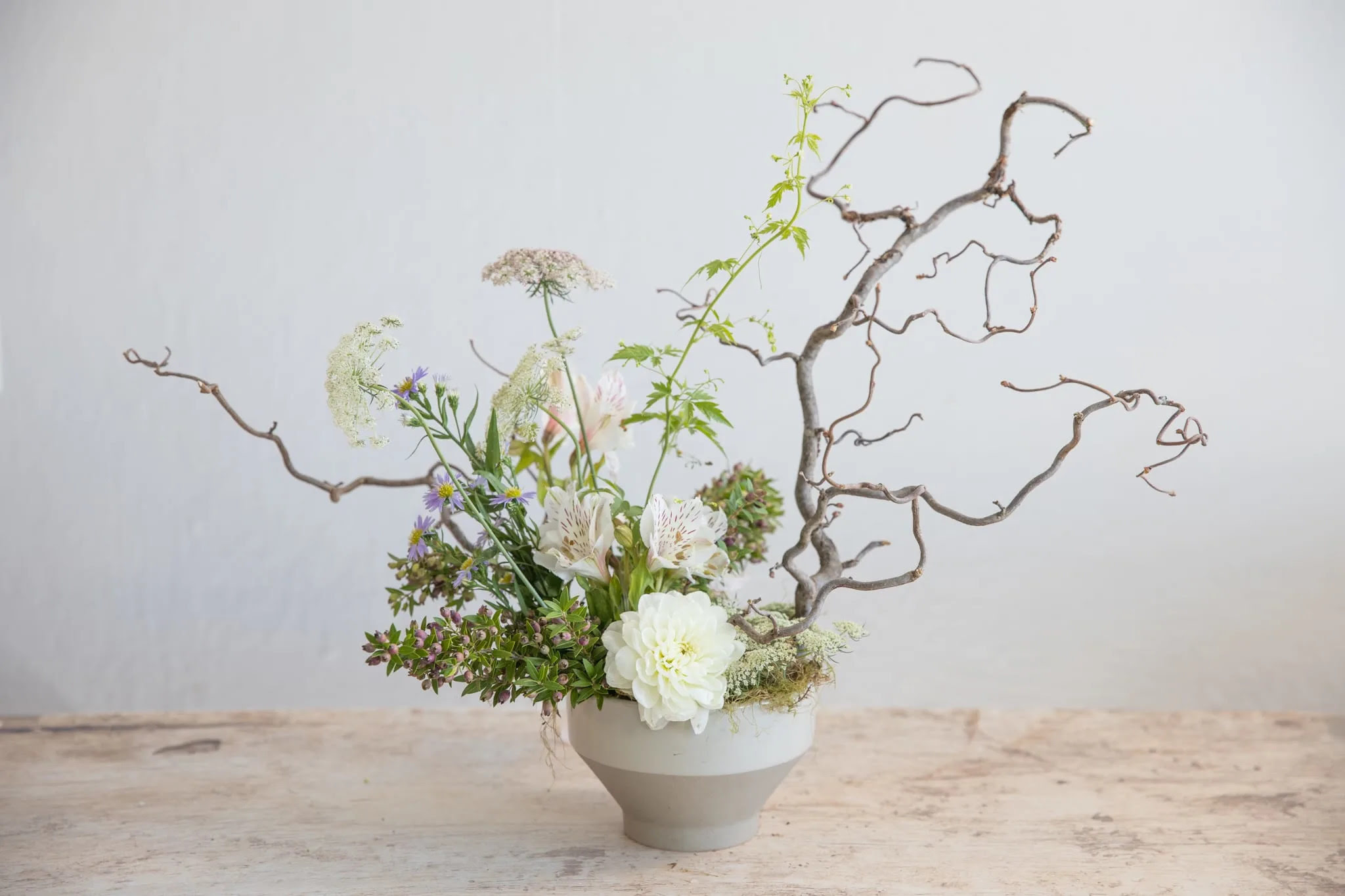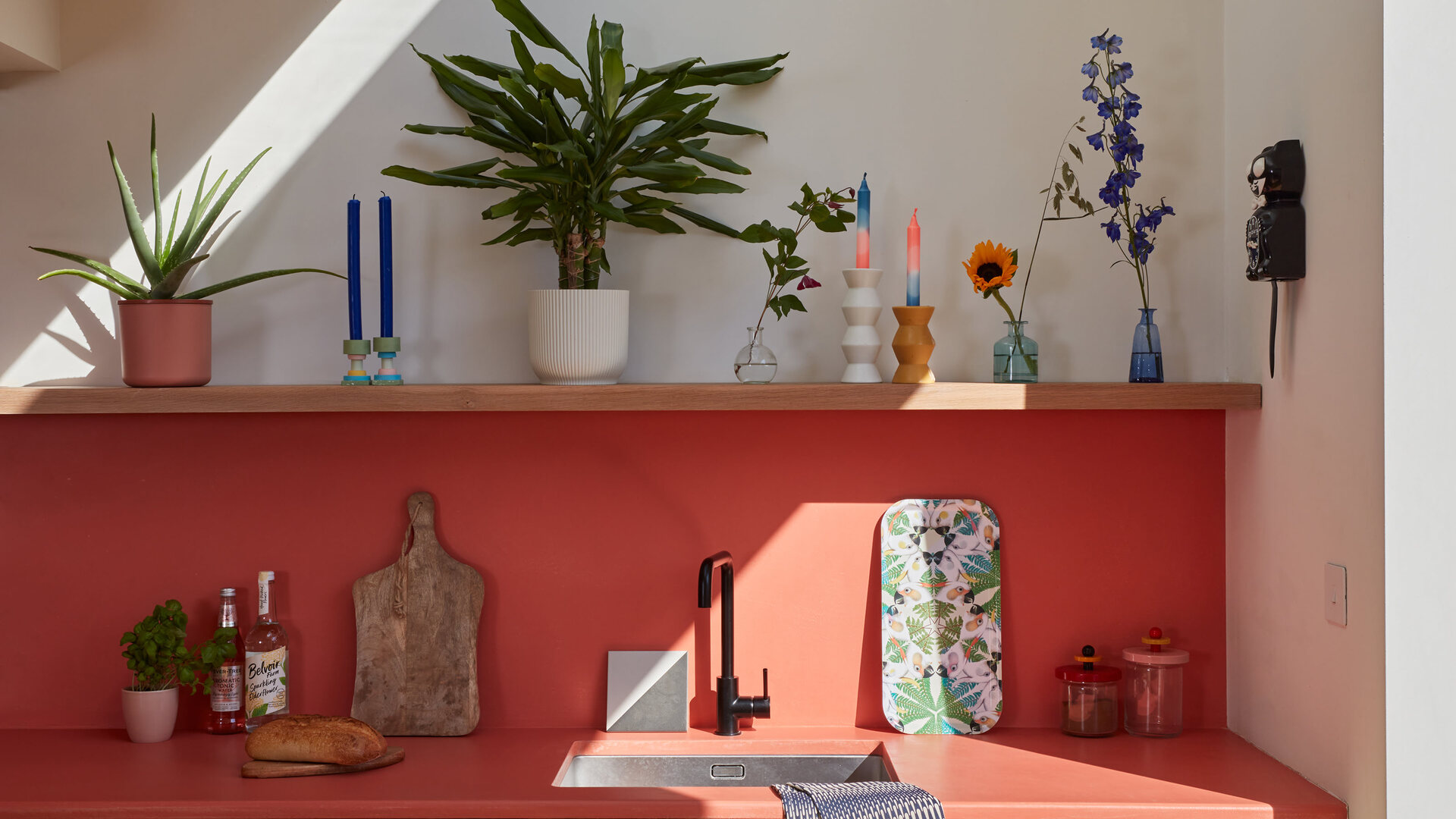Home>Interior Design>What Is Ikebana? A Florist Explains, And Shows How To Do It


Interior Design
What Is Ikebana? A Florist Explains, And Shows How To Do It
Modified: January 18, 2024
Learn all about ikebana, the traditional Japanese art of flower arrangement, from a knowledgeable florist. Discover how to create stunning designs and bring a touch of interior design elegance into your home.
(Many of the links in this article redirect to a specific reviewed product. Your purchase of these products through affiliate links helps to generate commission for Storables.com, at no extra cost. Learn more)
Introduction
Welcome to the world of Ikebana, the art of Japanese flower arrangement. Ikebana is not just about placing flowers in a vase; it is a deeply meaningful practice that has been cherished for centuries. In this article, we will explore the essence of Ikebana, its history, philosophy, different types, tools and materials required, as well as provide a step-by-step guide on how to create your own Ikebana arrangement.
Ikebana, also known as Kado, is derived from two Japanese words – “ike” meaning “alive” and “bana” meaning “flower.” It is an art form that goes beyond the mere aesthetics of decorating space with flowers. Ikebana is a way to connect with nature and express one’s emotions through the arrangement of flowers, branches, leaves, and other natural elements.
The origins of Ikebana can be traced back to the 6th century when Buddhism was introduced to Japan. It was during this time that floral offerings became an integral part of religious rituals. Over time, Ikebana evolved from a religious practice to a form of artistic expression.
Unlike traditional Western flower arrangements that focus on symmetry and a perfect balance of colors, Ikebana is characterized by its asymmetrical and minimalistic approach. Every element in an Ikebana arrangement has a deliberate placement, symbolizing natural beauty, movement, and harmony.
The philosophy behind Ikebana is deeply rooted in Japanese culture. It draws inspiration from the concept of simplicity, humility, and respect for nature. Ikebana practitioners aim to capture the essence of the seasons, incorporating elements that evoke a sense of tranquility and balance.
There are various schools of Ikebana, each with its own unique style and principles. Some of the most well-known styles include Ikenobo, Ohara, and Sogetsu. These schools have their own set of rules, techniques, and philosophies, allowing for a diverse range of creative expressions within the art form.
To create an Ikebana arrangement, you will need a few essential tools and materials. These include a Kenzan (pin frog) – a device used to hold the stems in place, a shallow container called a Suiban, sharp scissors or pruning shears, and of course, a selection of flowers, branches, and foliage.
In the following sections of this article, we will delve deeper into the history, philosophy, and techniques of Ikebana. By the end, you will have a comprehensive understanding of this beautiful art form and be ready to create your own Ikebana masterpiece.
Key Takeaways:
- Discover the profound art of Ikebana, a Japanese flower arrangement practice rooted in nature, mindfulness, and cultural values. Embrace asymmetry, negative space, and seasonal elements to create harmonious compositions.
- Unleash your creativity with Ikebana, exploring traditional and modern styles, tools, and techniques. Connect with nature, find inner peace, and express emotions through the beauty of floral arrangements.
Read more: What Can Alexa Echo Show Do
What is Ikebana?
Ikebana is a traditional Japanese art form that involves the arrangement of flowers, branches, and other natural materials in a way that creates a unique and harmonious composition. It is not just a decorative practice but a way to express creativity, emotions, and a deep appreciation for nature.
Unlike Western flower arrangements that often aim for a symmetrical and balanced appearance, Ikebana focuses on creating asymmetrical and minimalistic compositions. Each element in an Ikebana arrangement is carefully chosen and placed to convey a specific meaning or evoke a particular feeling.
The beauty of Ikebana lies in its simplicity and the attention to detail. It is about creating a harmonious relationship between the materials used, the container, and the space in which the arrangement is placed. The goal is to create a sense of balance, movement, and tranquility.
Ikebana is deeply rooted in Japanese culture and has its origins in the religious rituals of offering flowers to Buddhist altars. Over time, it evolved into an art form practiced by both Buddhist monks and the general public. Today, Ikebana is appreciated and practiced worldwide.
One of the key principles in Ikebana is the concept of “ma,” which refers to the space between objects. The empty space in an arrangement is just as important as the materials themselves, creating a sense of openness and allowing the viewer to appreciate the beauty of each element.
Another important aspect of Ikebana is the use of symbolism. Each flower, branch, or leaf carries its own symbolic meaning, and the arrangement as a whole may convey a message or represent a specific theme. Colors, shapes, and textures are carefully selected to enhance the overall aesthetic and evoke certain emotions.
Ikebana is also influenced by the seasons and the natural environment. Arrangements often incorporate elements that reflect the changing colors and textures of each season. This not only creates a connection with nature but also adds a sense of transience and impermanence, reminding us of the fleeting beauty of life.
Participating in Ikebana can be a deeply meditative and contemplative experience. It requires patience, focus, and a willingness to let go of preconceived notions of beauty. Through Ikebana, practitioners can find inner calmness, mindfulness, and a sense of harmony with the natural world.
Whether you are a beginner or an experienced floral enthusiast, exploring the art of Ikebana can be a rewarding and fulfilling journey. It allows you to step into a world of creativity, mindfulness, and connection with nature, all while creating stunning floral compositions that reflect your own unique style and sensibility.
The History of Ikebana
The art of Ikebana has a rich and fascinating history that dates back centuries. Its origins can be traced to the 6th century when Buddhism was introduced to Japan from China and Korea. During this time, floral offerings became an integral part of religious rituals, and the practice of Ikebana emerged from this religious context.
Initially, Ikebana was exclusively practiced by Buddhist monks, who used flowers to decorate altars as offerings to the Buddha. The arrangements were minimalistic and focused on simplicity, reflecting the Zen philosophy of embracing the beauty of imperfection and transience.
As time passed, the practice of Ikebana spread beyond the walls of temples and began to be embraced by the wider Japanese society. The aristocracy and samurai class developed their own styles and schools of Ikebana, each with its own set of rules and principles.
One of the most influential figures in the history of Ikebana is Senno Ikenobo, a Buddhist monk who lived during the 15th century. He is credited with establishing the Ikenobo school, which is considered the oldest and most prestigious school of Ikebana. Ikenobo emphasized the importance of incorporating natural elements into arrangements and introduced the use of the Kenzan, a pin frog, to hold the stems in place.
During the Edo period (1603-1868), Ikebana became popular among the merchant class and the general public. The Ohara school, founded by Ohara Koetsu in the 19th century, introduced the use of landscape elements and larger containers, allowing for more spacious and natural-looking arrangements.
In the 20th century, Sogetsu school emerged as a revolutionary force in the world of Ikebana. Founded by Sofu Teshigahara, Sogetsu challenged traditional rules and boundaries, encouraging practitioners to embrace their creativity and experiment with a wide range of materials, including unconventional ones like wire and metal.
Today, there are numerous schools of Ikebana, each with its own distinct style and philosophy. These schools continue to preserve and evolve the art form, passing down their knowledge and techniques from generation to generation.
Ikebana has also gained international recognition and popularity. It is now practiced and appreciated by people from different cultural backgrounds around the world. Ikebana exhibitions and competitions are held globally, showcasing the beauty and diversity of this ancient art form.
The history of Ikebana is a testament to its enduring appeal and the profound connection it creates between individuals, nature, and the beauty of the present moment. It is an art form that continues to inspire, bringing tranquility, mindfulness, and the beauty of the natural world into our lives.
The Philosophy of Ikebana
Ikebana is not just a floral arrangement; it is a way of life rooted in deep philosophical principles. The philosophy of Ikebana reflects traditional Japanese values and beliefs, emphasizing harmony, simplicity, and a profound appreciation for nature.
One of the fundamental principles behind Ikebana is the concept of “Ibasho,” which translates to “a place where one feels at home.” Ikebana encourages individuals to create a space where they can feel connected to nature and find inner peace. The arrangement becomes a physical representation of this sacred space, evoking a sense of tranquility and harmony.
Another core aspect of Ikebana philosophy is the idea of embracing imperfection and impermanence. Unlike Western floral arrangements that strive for perfection and symmetry, Ikebana embraces the natural beauty of asymmetry and acknowledges the transient nature of life. This concept is deeply rooted in the Japanese philosophy of “wabi-sabi,” finding beauty in things that are imperfect, impermanent, and incomplete.
Central to Ikebana is the principle of “Ma,” which refers to the space between objects. The empty space is considered just as important as the materials being used. It signifies the balance between the visible and the invisible, allowing the viewer to appreciate the negative space and find beauty in the void. Ma creates a sense of calmness and provides an opportunity for contemplation.
One of the key philosophies of Ikebana is the respect for nature. Practitioners of Ikebana believe in the interconnectedness of all living things and see themselves as facilitators in the creative process rather than creators. They carefully select and arrange flowers, branches, and other natural materials to showcase their inherent beauty, while respecting their natural forms and characteristics.
Through Ikebana, individuals can cultivate mindfulness and a deep appreciation for the present moment. The process of arranging flowers requires focus, concentration, and a heightened sense of awareness. It serves as a form of meditation, allowing practitioners to escape from the distractions of the outside world and find peace within themselves.
Ikebana also teaches the value of discipline and patience. The process of selecting materials, conditioning them, and arranging them with precision requires time and dedication. Ikebana practitioners learn to appreciate the art of slow and deliberate action, fostering a sense of tranquility and fulfillment.
Furthermore, Ikebana emphasizes the importance of simplicity and minimalism. By stripping down arrangements to their essential elements, practitioners can focus on the purity and elegance of each flower or branch. This simplicity aims to create a sense of calmness and to highlight the innate beauty of nature.
Overall, the philosophy of Ikebana is about finding beauty in simplicity, embracing imperfection, respecting nature, and cultivating mindfulness. It offers a path to connect with the natural world and ourselves, bringing a sense of harmony, peace, and contemplation into our lives.
Types of Ikebana
Ikebana, the Japanese art of flower arrangement, encompasses a wide range of styles and approaches. Each style carries its own unique characteristics, principles, and rules. Here are some of the most prominent types of Ikebana:
-
Read more: What Is Alexa Show
Ikenobo:
Ikenobo is considered the oldest and most traditional school of Ikebana. Founded in the 15th century, it emphasizes simplicity, elegance, and harmony with nature. The arrangements are typically triangular in shape and use a minimal number of stems. The Ikenobo style is known for its use of curved lines and the incorporation of empty space to create a sense of balance and movement.
-
Ohara:
The Ohara school, founded in the late 19th century, introduced a more spacious and naturalistic approach to Ikebana. Ohara arrangements often incorporate landscape elements such as rocks, branches, and water, to create a sense of depth and perspective. The style embraces asymmetry and emphasizes the use of seasonal flowers and foliage, capturing the essence of each season.
-
Sogetsu:
Sogetsu is a modern and experimental school of Ikebana established in the early 20th century. It focuses on self-expression and encourages practitioners to explore new materials, shapes, and techniques. Sogetsu arrangements can be minimalistic or avant-garde and often incorporate unconventional elements such as wire, metal, or even non-natural materials. This style allows for greater freedom and creativity in interpreting the art of Ikebana.
-
Shoka:
Shoka style, which originated in the 18th century, can be seen as the foundation of Ikebana. It follows a strict set of rules and principles called the “Shoka Shimputai.” Shoka arrangements consist of three main lines representing heaven, earth, and humanity. This style emphasizes the use of natural materials and the concept of asymmetry to create a sense of movement and harmony.
-
Nageire:
Nageire style, meaning “thrown in,” is one of the oldest forms of Ikebana. Developed during the 16th century, this style involves arranging flowers in a tall, upright manner, symbolizing the blossoms growing naturally in the wild. Nageire arrangements use fewer structural materials and focus predominantly on capturing the beauty and essence of a few carefully chosen flowers or branches.
These are just a few examples of the various styles of Ikebana that exist. Each type has its own philosophies, rules, and techniques, allowing practitioners to explore and express their creativity in different ways. Regardless of the style chosen, Ikebana provides a unique and artistic approach to flower arrangement that goes beyond mere aesthetics, connecting individuals with nature and evoking emotions through the beauty of each creation.
Tools and Materials Needed for Ikebana
Ikebana, the Japanese art of flower arrangement, requires a few essential tools and materials to create stunning compositions. These tools help practitioners carefully shape and arrange flowers, branches, and other natural elements. Here is a list of some of the key tools and materials needed for Ikebana:
-
Kenzan (Pin Frog):
A Kenzan, or pin frog, is a key tool used in Ikebana. It is a device made of brass or stainless steel with small pins that hold the stems of flowers and branches in place. The pins ensure stability and allow for precise placement within the arrangement. Kenzan comes in different shapes and sizes to accommodate various containers.
-
Suiban (Shallow Container):
A Suiban is a shallow container specifically designed for Ikebana arrangements. It can be made of ceramic, glass, or metal. The Suiban provides a stable base for the arrangement and allows for the incorporation of water or other additional elements, such as pebbles or sand, to enhance the overall aesthetic.
-
Read more: What Television Shows Are On Hulu?
Scissors or Pruning Shears:
Sharp scissors or pruning shears are essential tools for cutting and trimming flowers and branches. They allow for clean and precise cuts, ensuring the longevity of the plant materials used in the arrangement. It’s important to keep the blades sharp to avoid crushing or damaging the stems.
-
Water Container:
A water container is used to hold water for fresh flowers and branches. It can be a small vase or a ceramic container specifically designed for Ikebana. The water container ensures that the plant materials remain hydrated and fresh throughout the arrangement process.
-
Flowers, Branches, and Foliage:
The selection of flowers, branches, and foliage is a crucial part of Ikebana. Different types of flowers carry different meanings and symbolism. It is important to consider the color, shape, texture, and form of each element in relation to the overall composition. Seasonal flowers and foliage are often preferred to reflect the changing natural environment. It’s essential to choose fresh, healthy materials for a visually appealing arrangement.
-
Additional Decorative Elements:
Depending on the style and concept of your Ikebana arrangement, you may choose to incorporate additional decorative elements. This can include rocks, pebbles, sand, or other natural materials that complement the overall aesthetic and theme of the arrangement.
These are the basic tools and materials required to practice Ikebana. As you delve deeper into the art form, you may explore additional tools and experiment with different containers and unique materials based on your creative vision. Remember, Ikebana is an artistic expression that embraces the beauty of simplicity and the harmonious relationship between nature, space, and the human touch.
Read more: Do Mirrors Show How You Really Look
Step-by-Step Guide to Creating Ikebana
Creating an Ikebana arrangement is a mindful and artistic process that involves careful consideration and a deep appreciation for nature. Follow this step-by-step guide to start creating your own Ikebana masterpiece:
-
Select your materials:
Choose a variety of flowers, branches, and foliage that reflect the season and your desired aesthetic. Consider the colors, textures, and shapes of the materials to create a visually appealing arrangement.
-
Prepare your materials:
Clean and condition your flowers and branches by removing any excess leaves or thorns. Cut the stems at an angle to allow for better water absorption and prolong the life of your arrangement.
-
Prepare your container:
If using a Suiban, fill it with water and add any additional decorative elements such as rocks or sand. If using a water container, fill it with water and place a Kenzan securely at the bottom.
-
Read more: How To Arrange Ikebana Floral Arrangements
Arrange the main stem:
Select a prominent main stem and place it in the container, slightly angled to one side. This is the backbone of your arrangement and will give it structure.
-
Add supporting branches:
Place additional branches or supporting materials around the main stem, creating a balance of height, width, and asymmetry. These branches will provide a framework for the rest of your arrangement.
-
Add secondary flowers and foliage:
Select a few complementary flowers and foliage to add depth and color to your arrangement. Insert them into the Kenzan or place them strategically within the composition, considering the negative spaces and the overall balance of the design.
-
Consider negative space:
Embrace the concept of “ma” – the space between objects – in your composition. Allow for negative space to create a sense of openness and visual harmony. Use the empty areas as an integral part of your design, making it feel spacious and effortless.
-
Read more: What Television Shows Are On CBS Tonight?
Step back and assess:
Take a step back and observe your arrangement from different angles. Adjust the positioning of flowers, branches, and foliage as needed to achieve a harmonious and balanced composition.
-
Final touches:
Once you are satisfied with the overall arrangement, make any final adjustments. Trim any excess foliage or stems, and ensure that all elements are securely in place.
Remember, Ikebana is an art form that encourages individual creativity and expression. Feel free to experiment with different styles, materials, and techniques to create arrangements that reflect your unique vision and personal connection with nature. Enjoy the process of creating Ikebana and let the beauty of your arrangement inspire tranquility and serenity in your space.
Tips and Techniques for Ikebana
Ikebana, the art of Japanese flower arrangement, requires a combination of technical skill, artistic sensibility, and a deep understanding of the principles behind this ancient art form. Here are some tips and techniques to enhance your Ikebana practice:
-
Study the principles:
Take the time to study and understand the principles of Ikebana, such as balance, asymmetry, and the use of negative space. Explore different styles and schools of Ikebana to gain insights into the various approaches and aesthetics.
-
Connect with nature:
Immerse yourself in nature to draw inspiration for your Ikebana arrangements. Observe the shapes, colors, and textures of flowers, branches, and foliage. Pay attention to how they grow and interact with the environment.
-
Create depth and dimension:
Play with different heights and angles to create depth and dimension in your arrangement. Vary the lengths of stems and branches, placing some taller and others shorter. This technique adds visual interest and creates a dynamic composition.
-
Experiment with color and texture:
Explore the beauty of color and texture by combining different flowers, branches, and foliage. Experiment with contrasting and complementary colors to create focal points and evoke certain moods. Play with textures to add visual and tactile interest to your arrangement.
-
Consider the container:
Choose a container that harmonizes with your arrangement. Consider the size, shape, and color of the container to complement the flowers and foliage. Use the container as a design element, allowing it to contribute to the overall aesthetic of the arrangement.
-
Read also: 14 Best Ikebana Vase for 2024
Embrace asymmetry:
Ikebana is known for its asymmetrical compositions. Embrace this principle and avoid creating perfectly symmetrical arrangements. Instead, strive for a balance between the different elements by placing them at varying heights and positions.
-
Be mindful of negative space:
Negative space, or “ma,” is an essential part of Ikebana. Leave empty spaces within your arrangement to guide the viewer’s eye and create a sense of balance and harmony. Allow the negative space to be as much a part of the design as the flowers and branches themselves.
-
Observe and adjust:
Regularly step back and observe your arrangement from different angles. Assess the placement, balance, and overall visual impact. Make necessary adjustments by repositioning or adding/removing elements to achieve the desired composition.
-
Practice patience and mindfulness:
Ikebana is a practice that requires patience, focus, and mindfulness. Take your time in arranging each stem and appreciate the process. Allow yourself to be fully present and connected with the natural materials and the creative act of arranging them.
-
Read more: What To Do If A Customer Does Not Show Up For A Home Repair Appointment With The Contractor
Continual learning and experimentation:
Never stop learning and experimenting with Ikebana. Attend workshops, exhibitions, and demonstrations to gain insights from experienced practitioners. Explore different styles, techniques, and materials to broaden your understanding and expand your creative possibilities.
Remember, Ikebana is an art form that allows for personal expression and reflection. While these tips and techniques provide a foundation, feel free to adapt and interpret them in your own unique way. Ikebana is about capturing the beauty and essence of nature while expressing your individual creativity and connection with the world around you.
Conclusion
Ikebana, the art of Japanese flower arrangement, offers a mesmerizing and profound way to connect with nature, express creativity, and find inner peace. It is an art form that goes beyond mere decoration, embodying deep philosophical principles and cultural values. Through Ikebana, we can create harmonious compositions that reflect the beauty of the natural world and evoke emotions within us.
In this article, we explored the essence of Ikebana, its history, philosophy, different styles, and the tools and materials needed for its practice. We learned that Ikebana is not simply arranging flowers in a vase, but a mindful practice that embraces asymmetry, simplicity, and the use of negative space. We discovered the various schools of Ikebana, each with its own unique style and approach, from the traditional Ikenobo and Ohara schools to the modern and experimental Sogetsu school.
We also explored the tools and materials essential for Ikebana, such as the Kenzan (pin frog) for holding stems in place, the Suiban (shallow container) for creating a stable base, and the importance of carefully selecting fresh flowers, branches, and foliage to capture the essence of each arrangement. Furthermore, we provided a step-by-step guide to help you create your own Ikebana masterpiece, along with tips and techniques to enhance your practice.
As you embark on your own Ikebana journey, remember to approach it with patience, mindfulness, and a willingness to embrace imperfection. Cherish the beauty of nature, appreciate the balance of negative space, and experiment with different styles and techniques. Allow Ikebana to be a form of self-expression, a way to find tranquility and create a space where you can feel truly at home.
Whether you are a beginner or an experienced practitioner, Ikebana holds the power to transform your relationship with nature and ignite your artistic spirit. It is an art form that transcends cultural boundaries, bringing a sense of serenity and beauty into our lives. So, immerse yourself in the transformative world of Ikebana and let your creativity bloom.
Frequently Asked Questions about What Is Ikebana? A Florist Explains, And Shows How To Do It
Was this page helpful?
At Storables.com, we guarantee accurate and reliable information. Our content, validated by Expert Board Contributors, is crafted following stringent Editorial Policies. We're committed to providing you with well-researched, expert-backed insights for all your informational needs.







0 thoughts on “What Is Ikebana? A Florist Explains, And Shows How To Do It”